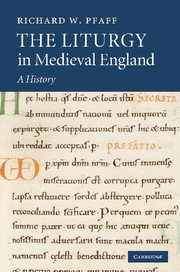Book contents
- Frontmatter
- Contents
- Preface
- Sigla and editorial conventions
- Bibliographical abbreviations
- Nicknames for manuscripts frequently referred to
- 1 Introduction
- Excursus: on sources
- 2 Early Anglo-Saxon England: a partly traceable story
- Excursus: on the terms Gregorian and Gelasian as used here
- 3 Later Anglo-Saxon: liturgy for England
- 4 The Norman Conquest: cross fertilizations
- Excursus: on method in the comparison of liturgical texts
- 5 Monastic liturgy, 1100–1215
- Excursus: on ascription of liturgical books to specific churches
- 6 Benedictine liturgy after 1215
- 7 Other monastic orders
- 8 The non-monastic religious orders: canons regular
- 9 The non-monastic religious orders: friars
- Excursus: on liturgical books from female religious houses
- 10 Old Sarum: the beginnings of Sarum Use
- 11 New Sarum and the spread of Sarum Use
- 12 Exeter: the fullness of secular liturgy
- 13 Southern England: final Sarum Use
- 14 Regional Uses and local variety
- 15 Towards the end of the story
- Index of Manuscripts
- Index of Saints
- General Index
12 - Exeter: the fullness of secular liturgy
Published online by Cambridge University Press: 20 March 2010
- Frontmatter
- Contents
- Preface
- Sigla and editorial conventions
- Bibliographical abbreviations
- Nicknames for manuscripts frequently referred to
- 1 Introduction
- Excursus: on sources
- 2 Early Anglo-Saxon England: a partly traceable story
- Excursus: on the terms Gregorian and Gelasian as used here
- 3 Later Anglo-Saxon: liturgy for England
- 4 The Norman Conquest: cross fertilizations
- Excursus: on method in the comparison of liturgical texts
- 5 Monastic liturgy, 1100–1215
- Excursus: on ascription of liturgical books to specific churches
- 6 Benedictine liturgy after 1215
- 7 Other monastic orders
- 8 The non-monastic religious orders: canons regular
- 9 The non-monastic religious orders: friars
- Excursus: on liturgical books from female religious houses
- 10 Old Sarum: the beginnings of Sarum Use
- 11 New Sarum and the spread of Sarum Use
- 12 Exeter: the fullness of secular liturgy
- 13 Southern England: final Sarum Use
- 14 Regional Uses and local variety
- 15 Towards the end of the story
- Index of Manuscripts
- Index of Saints
- General Index
Summary
Although among secular establishments in medieval England it is always Salisbury, the home of the Sarum Use, that occupies center stage, Exeter cathedral is actually the building for which some sense of liturgical life over a period of centuries can be most fully constructed. This is owing primarily, but by no means exclusively, to the ambitious work of two great bishops of the see, Leofric, 1050–72, and John de Grandisson, 1327–69. Leofric's achievement was surveyed at the end of chapter 4, which dealt with the period of the Norman Conquest. There is little, if any, discernible continuity between his liturgical program and that of Grandisson; no part of Leofric's building was extant in the fourteenth century, and whatever influences had been most substantial in the various books that are connected with him were long since submerged in the flood emanating from New Sarum. Nonetheless, a distinct “Exeter” liturgical identity is evident in the program envisaged by Grandisson, an identity of which we can glimpse hints in the episcopates of some of his predecessors.
For there seems to have been, to a perhaps unusual degree, a self-consciousness connected with holding the see of Exeter. This may be seen already in the set of prayers in Leofric missal “C” for a Missa propria pro episcopo, most likely composed (as noted earlier) by Leofric himself. The bishop of Exeter is mentioned in all three prayers, with language – like “me famulum tuum. ill. [the name to be supplied] non meis meritis, sed dono tuae gratiae, pontificali cathedra exoniensium sublimasti” – which makes explicit his hope that it will be used by his successors.
- Type
- Chapter
- Information
- The Liturgy in Medieval EnglandA History, pp. 388 - 411Publisher: Cambridge University PressPrint publication year: 2009



